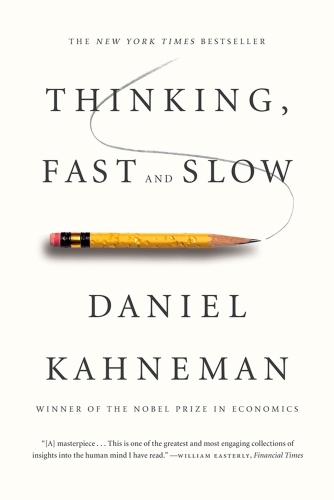
2020-07-07
We’ve recently read Thinking, Fast and Slow in the book club at work. The book took its toll in the form of everybody except three people giving up sooner or later, and I’ll admit that I found it hard work to get through: I’d have to highlight while reading, and then write a short summary for each chapter, or everything would be a total blur after a few weeks.

I’m not going to summarize the book—there are a lot of summaries out there already—and I’m not really going to review it (see Goodreads for more than 9000 reviews in English alone). Instead, I want to summarize my concrete takeaways.
Chapter 4 (“The Associative Machine”) talks about an “honesty box” that was set up in a university kitchen: people put money in it for the milk they took. Next to the box was a picture, and the observation was that the amount left per litre of milk increased when there was a poster with eyes on the wall (as opposed to, say, flowers). The context is “priming”.
At work, I’m sometimes annoyed when people leave their dirty dishes in the sink (or I used to be, before working from home full-time). I always wanted to put up a picture of a security camera as a tongue-in-cheek reminder, and the experiment seems to confirm that this kind of thing would actually have a measurable impact.
The takeaway would be to put up such a picture for real; I’ll revisit next year, I guess!
In Chapter 7 (“A Machine for Jumping to Conclusions”), the Halo effect is discussed; an example is judging essays, where the quality of the first essay by a student would affect how the second one would be judged. Kahneman describes how he adopted a new procedure where he’d judge all first answers, then all second answers, and made sure to not see how the first one was graded when looking at the second one.
A side effect of this was feeling less confident about the grading.
My takeaway: when soliciting ideas in a meeting or discussing a candidate after an interview, everybody should write down what they want to say first; otherwise, the first statement is going to bias all others.
Chapter 12 (“The Science of Availability”) has an example where couples were asked how much they think they contribute to doing household chores, and the answers always summed up to more than 100% per couple.
I know of 100% of the instances where I did something (because I was there), but I’m going to miss work others did—I shouldn’t assume it didn’t happen just because I’m not aware of it.
People are poor judges when evaluating complex information; as per Chapter 21 (“Intuition vs. Formulas”), simple algorithms perform better than experts. There are great examples with an algorithm that predicts wine prices based on a few weather inputs, and the Apgar test to assess if the breathing of a newborn should be considered normal or not.
Applied to interviews, the recommendation is to use a list of qualities desired in a candidate with associated questions each, and the interviewer should more or less just go through these questions. If the interviewer does not make the final decision on hire / no hire, they can be allowed to add a summary judgment, which can be given quite some weight; if they make the decision, they should only use the list of questions.
People overestimate how good they are at something something because they substitute that assessment by how comfortable they feel doing it; this results in everybody thinking they’re an above average driver, or many movie releases falling on the same weekend (Chapter 24, “The Engine of Capitalism”).
Optimism can help with resilience, and in some cases, falsehoods are preferred to honest uncertainties (from a doctor, for example); it can also lead to entrepreneurs continuing their efforts even when they have been told reliably that their chances are bad.
The premortem is a method to remedy the planning fallacy somewhat: when close to a decision, people should describe how, one year in the future, the plan completely and utterly failed. This can overcome groupthink, legitimize doubt, and uncover threats.
When faced with a gamble, people tend to prefer a guaranteed gain of less than the expected value over the risk of not getting anything at all (Chapter 31, “Risk Policies”).
Instead, one should prefer the gamble if the expected value is higher—over the course of many gambles, they’ll approximate their expected values. The gambles should satisfy these conditions:
A concrete application of this is checking one’s investments infrequently, for example just once a quarter.
I found a few more parts very interesting, but couldn’t translate them to something concrete enough to be considered a “takeaway”.
This is discussed in Chapter 26 (“Prospect Theory”); the fear of losing $100 is stronger than the hope of gaining $150. A takeaway could be that if you want somebody to want something, instead of telling them how great the thing is, you give it to them and then take it away again—like a car salesperson letting you test drive a car all by yourself.
How something is remembered is dominated by its most extreme moment and its end (Chapter 35, “Two Selves”). An example is how pain is remembered: longer duration of the pain overall is preferable to shorter with a painful end.
And there you have it! Six concrete things to actually do.